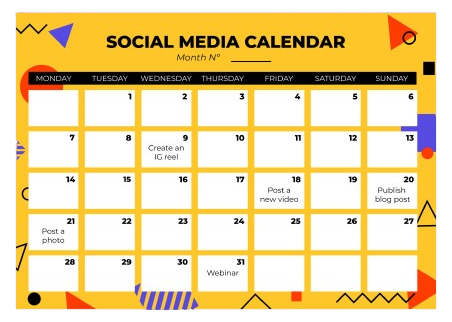
As in today’s fast-moving digital world, social media has become so central to personal branding, business outreach, and community building. From Instagram and Facebook through to LinkedIn and TikTok, each offers possibilities for engaging another group of people. But managing more than one or a couple of these social media sites quickly starts to feel completely overwhelming-especially as you try to maintain content creation, analytics, and keep up with changes in trends. Success is all about organization, planning, and using the right tools.
If you find it hard to maintain a regular presence on your social media platforms, this guide will give you some actionable tips on how to manage your accounts like a seasoned pro. From creating a clear content strategy to automating where possible, these strategies will help you streamline your efforts and maximize your online impact.
1. Develop a Content Strategy

Creating a content strategy is the foundation of managing multiple social media accounts efficiently. Each social media platform attracts different types of audiences, and the content you share must align with each platform’s unique environment to drive engagement. To make the most of your social media presence, start by defining your goals—whether it’s increasing brand awareness, driving website traffic, or building a community.
- Instagram thrives on visual content, such as high-quality images, engaging stories, and eye-catching reels. Your goal here should be to showcase products, offer sneak peeks into your business, and use visual storytelling to connect with your audience.
- Twitter is fast-paced and best suited for concise, witty, and timely updates. Use this platform to share quick thoughts, industry news, or engage in trending conversations using relevant hashtags.
- LinkedIn serves as a professional network, making it ideal for sharing industry insights, company updates, and networking with other professionals. Thought leadership content, such as articles or long-form posts, works well here.
- Facebook allows for a mix of content, including videos, images, and longer posts that can dive deeper into product features, testimonials, or behind-the-scenes content.
Key Actions to Consider:
A well-organized content calendar is essential. Plan your posts in advance to maintain consistency. This prevents last-minute scrambling and allows you to batch-create content.
Create content once and adapt it to suit each platform. For example, a blog post can be summarized into a Twitter thread or turned into an Instagram carousel post.
Segment your content into different themes, such as industry news, behind-the-scenes looks, product launches, and customer stories. This variety helps keep your content fresh and prevents audience fatigue.
2. Use Social Media Management Tools
 Managing multiple social media accounts manually can lead to inefficiency and oversights. Social media management tools are invaluable in automating tasks, scheduling posts, tracking performance, and monitoring engagement. These tools save you time, helping you stay organized and consistent across platforms.
Managing multiple social media accounts manually can lead to inefficiency and oversights. Social media management tools are invaluable in automating tasks, scheduling posts, tracking performance, and monitoring engagement. These tools save you time, helping you stay organized and consistent across platforms.
Top Social Media Management Tools:
- Hootsuite: This tool allows you to schedule posts in advance, monitor multiple social accounts in one place, and track engagement across different platforms.
- Buffer: A user-friendly tool that helps you schedule posts, analyze your performance, and manage content curation efficiently.
- Sprout Social: This platform offers comprehensive social media management, including team collaboration, analytics, and post scheduling. It’s ideal for businesses looking to manage multiple accounts while keeping team workflows streamlined.
- Later: If you’re more focused on visual content, like Instagram or Pinterest, Later makes it easy to plan, schedule, and visualize your posts.
By integrating these tools into your workflow, you can automate scheduling, track content performance, and save yourself the hassle of switching between different platforms repeatedly.
3. Create a Content Calendar
 A content calendar acts as your blueprint for consistency. It helps you manage your posting schedule, ensuring that you’re not only active across all platforms but also that your content aligns with peak times of engagement. Planning your content in advance reduces the stress of creating posts at the last minute and allows you to maintain a balance between different types of content.
A content calendar acts as your blueprint for consistency. It helps you manage your posting schedule, ensuring that you’re not only active across all platforms but also that your content aligns with peak times of engagement. Planning your content in advance reduces the stress of creating posts at the last minute and allows you to maintain a balance between different types of content.
- Batch Content Creation: Allocate specific time slots to create content in bulk. For example, dedicate one day a week to design all your visuals, while another day is reserved for drafting captions. This method improves efficiency and allows you to focus on creativity.
- Content Optimization: Optimize your content for each platform by tailoring it to fit the visual and text-based standards. For instance, Instagram posts typically perform well with bright, colorful visuals, while Twitter may require shorter and snappier text.
- Track Performance: Use your content calendar to analyze what works. If a certain post style or timing performs well, note these insights and incorporate them into your future content strategy.
4. Monitor Performance and Analytics
Tracking your social media performance is critical for improving your strategy. Each platform provides built-in analytics tools that offer a wealth of data—like likes, shares, comments, impressions, and follower growth. By analyzing these insights, you can gain a clearer understanding of what types of content engage your audience the most and where you may need to adjust your approach.
Key Metrics to Watch:
- Measure the interaction on your posts, such as likes, comments, and shares. High engagement indicates your content resonates with your audience.
This metric shows how many users have seen your posts. A high impression count can help you determine the reach of your content.
Track how many people click on links in your posts. This helps assess how effective your call-to-action is.
Pay attention to the growth of your followers, especially across platforms where engagement may vary.
Analyzing these metrics gives you valuable insights into what type of content resonates best with your audience, helping you refine your strategy over time.
5. Engaging with Your Audience
 Social media is all about fostering meaningful connections. Once you’ve posted content, engagement doesn’t stop there. Engaging with your audience regularly helps build trust, increase visibility, and strengthen relationships with your followers.
Social media is all about fostering meaningful connections. Once you’ve posted content, engagement doesn’t stop there. Engaging with your audience regularly helps build trust, increase visibility, and strengthen relationships with your followers.
- Respond to Comments and Messages: Actively engage with your audience by responding to comments on your posts and answering direct messages. This helps humanize your brand and shows followers that you value their feedback.
- Use Stories and Live Videos: Stories and live videos offer real-time interaction opportunities. Use these formats to showcase behind-the-scenes moments, conduct Q&A sessions, or give updates on your brand or product.
- Polls and Quizzes: Utilize interactive features like polls, quizzes, or question stickers to encourage participation. These tactics can be engaging and drive more user interaction.
- Celebrate Your Followers: Shout out loyal followers or customers who actively engage with your content. This builds community and makes your audience feel valued.
Engaging with your audience in these ways can amplify your reach and help your content gain traction.
6. Stay Organized with Tools
To keep your social media accounts running smoothly, staying organized is crucial. Without proper organization, it’s easy to lose track of tasks, miss posting deadlines, or neglect important follow-ups.
- Trello
 Trello is an excellent project management tool that allows you to organize your content ideas, campaigns, and tasks into boards and lists. It’s great for team collaboration and task delegation.
Trello is an excellent project management tool that allows you to organize your content ideas, campaigns, and tasks into boards and lists. It’s great for team collaboration and task delegation. - Google Sheets
 Utilize Google Sheets to track your analytics, plan your content calendar, and store performance data. This makes it easy to share progress across your team and keep everyone on the same page.
Utilize Google Sheets to track your analytics, plan your content calendar, and store performance data. This makes it easy to share progress across your team and keep everyone on the same page. - Asana
 Asana is another project management tool that helps you manage tasks, deadlines, and campaigns. It’s ideal for businesses that need to coordinate efforts across various platforms and teams.
Asana is another project management tool that helps you manage tasks, deadlines, and campaigns. It’s ideal for businesses that need to coordinate efforts across various platforms and teams.
With these tools, you can ensure your workflow is streamlined, and no task falls through the cracks.
7. Monitor Competitors and Stay Updated
Keeping an eye on what your competitors are doing can provide fresh inspiration and help you stay relevant in your niche. By analyzing your competitors’ strategies, you can discover new content ideas, engage in trending conversations, and adopt successful tactics.
- Track Competitor Content: Use tools like Google Alerts, Hootsuite, or Brandwatch to monitor what your competitors are posting and how their audience is responding.
- Join Industry Conversations: Participate in trending hashtags, industry-specific discussions, and conversations relevant to your brand. Staying aware of current trends helps you adapt your strategy accordingly.
- Experiment with New Features: Social media platforms regularly introduce new features, such as Instagram Reels, Twitter Spaces, or LinkedIn Articles. By experimenting early, you can find unique ways to stand out.
8. Automate Where Possible
While human engagement is essential, automating certain aspects of social media management can save you time and reduce repetitive tasks. However, it’s important to strike a balance between automation and maintaining a personal touch.
- Scheduling Tools: Tools like Hootsuite and Buffer allow you to schedule your posts in advance, ensuring your content goes live at the right times without you needing to be online constantly.
- Content Curation Tools: Use tools like Feedly or Pocket to curate content relevant to your audience. You can schedule these posts to go out throughout the week, ensuring fresh and engaging content.
- Chatbots: Implement chatbot solutions to respond to frequently asked questions. This can save time while still providing helpful and instant responses to your audience.
Conclusion
Managing multiple social media accounts effectively is no longer just a skill—it’s an essential part of building a strong online presence, whether you’re an individual, a small business owner, or a marketing professional. It requires a balance of creativity, strategic planning, and technical expertise to ensure that each platform reflects your brand’s voice while catering to its unique audience. By implementing a well-defined content strategy, leveraging powerful tools for automation and analytics, and maintaining consistent engagement, you can transform your social media efforts from chaotic to coordinated.
The key to success lies in treating your social media accounts not as separate entities but as parts of a cohesive ecosystem. This means creating content that tells a unified story across platforms while tailoring the tone and format to suit each audience. Use insights from analytics to guide your decisions, refine your approach, and identify new opportunities to connect with your followers.
While automation tools can save time, it’s essential to retain the human touch—whether through personalized responses to comments, meaningful interactions, or creative content that resonates on an emotional level. Social media isn’t just about marketing; it’s about building relationships, trust, and loyalty with your audience over time.
Remember, success doesn’t happen overnight. The digital landscape is dynamic, and staying adaptable is crucial. Social media trends, algorithms, and user preferences are constantly evolving, so continuous learning and experimentation are necessary to stay ahead of the curve.
Ultimately, managing multiple social media accounts like a pro is about mastering both the art and science of digital communication. By staying organized, setting clear goals, and committing to a consistent strategy, you can build a social media presence that not only grows your brand but also inspires and engages your audience in meaningful ways. The effort you invest today will pave the way for long-term success, helping you create a thriving digital community that amplifies your voice in the ever-growing social media space.
